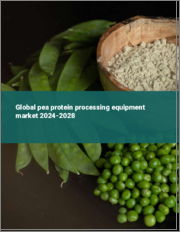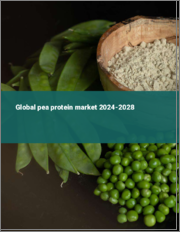
|
시장보고서
상품코드
1622421
노란 완두콩 단백질 시장 규모, 점유율, 성장 분석 : 제품 유형별, 형태별, 용도별, 최종사용자별, 지역별 - 산업 예측(2025-2032년)Yellow Pea Protein Market Size, Share, Growth Analysis, By Product Type (Pea Protein Concentrates, Pea Protein Isolates), By Form (Dry, Liquid), By Application, By End-User, By Region - Industry Forecast 2025-2032 |
||||||
노란 완두콩 단백질 시장 규모는 2023년 21억 4,000만 달러로 평가되며, 2024년 24억 1,000만 달러에서 2032년 63억 2,000만 달러로 성장할 것으로 예상되며, 예측 기간(2025-2032년) 동안 12.8%의 CAGR로 성장할 것으로 예상됩니다.
세계 노란 완두콩 단백질 시장은 최근 몇 년 동안 단백질 대안을 찾는 건강 지향적 소비자의 급증에 힘입어 크게 성장하고 있습니다. 노란 완두콩 단백질의 건강 효과에 대한 인식이 높아짐에 따라 그 인기가 확대되어 동물성 단백질과 콩 단백질의 우위에 도전하고 있습니다. 라이신, 항진균성 생체 활성 펩타이드, 식이 렉틴 및 기타 유익한 특성을 풍부하게 함유하고 있는 노란 완두콩 단백질은 지속가능성, 저알레르기성, 건강 증진 등 다양한 이점을 제공합니다. 이러한 관심의 증가는 소비자들이 보다 명확한 라벨링, 풍미 있는 제품, 식생활에 맞는 다양한 단백질 공급원을 찾고 있기 때문에 시장 확대에 박차를 가할 것으로 예상됩니다. 전반적으로 노란 완두콩 단백질 시장은 식물성 대체 식품이라는 광범위한 트렌드에 발맞춰 빠르게 성장할 수 있는 여건을 갖추고 있습니다.
목차
소개
- 조사 목적
- 조사 범위
- 정의
조사 방법
- 정보 조달
- 2차 데이터와 1차 데이터 방법
- 시장 규모 예측
- 시장 가정과 제한
주요 요약
- 세계 시장 전망
- 공급과 수요 동향 분석
- 부문별 기회 분석
시장 역학과 전망
- 시장 개요
- 시장 규모
- 시장 역학
- 성장 촉진요인과 기회
- 성장 억제요인과 과제
- Porters 분석
주요 시장 인사이트
- 핵심성공요인
- 경쟁 정도
- 주요 투자 기회
- 시장 생태계
- 시장 매력 지수(2024년)
- PESTEL 분석
- 거시경제 지표
- 밸류체인 분석
- 가격 분석
- 규제 상황
- 특허 분석
- 사례 연구
- 고객과 구매 기준 분석
노란 완두콩 단백질 시장 규모 : 제품 유형별
- 시장 개요
- 완두콩 단백질 농축물
- 완두콩 단백질 분리물
- 고단백질
- 우수한 유화·안정성
- 텍스처드 완두콩 단백질
- 가수분해 완두콩 단백질
노란 완두콩 단백질 시장 규모 : 형태별
- 시장 개요
- 드라이
- 액체
노란 완두콩 단백질 시장 규모 : 용도별
- 시장 개요
- 고기 대체품
- 베이커리 제품
- 음료
- 에너지 드링크
- 과일 믹스
- 스낵 & 시리얼
- 식이보충제
- 기타
- 유제품 대체품
- 제과
노란 완두콩 단백질 시장 규모 : 최종사용자별
- 시장 개요
- 식품 및 음료 업계
- 스포츠 영양
- 동물 사료
- 의약품
- 화장품
노란 완두콩 단백질 시장 규모
- 북미
- 미국
- 캐나다
- 유럽
- 독일
- 스페인
- 프랑스
- 영국
- 이탈리아
- 기타 유럽
- 아시아태평양
- 중국
- 인도
- 일본
- 한국
- 기타 아시아태평양
- 라틴아메리카
- 브라질
- 기타 라틴아메리카
- 중동 및 아프리카
- GCC 국가
- 남아프리카공화국
- 기타 중동 및 아프리카
경쟁 정보
- 상위 5개사의 비교
- 주요 기업의 시장 포지셔닝(2024년)
- 주요 시장 기업이 채용한 전략
- 시장의 최근 동향
- 기업의 시장 점유율 분석(2024년)
- 주요 기업 개요
- 기업 개요
- 제품 포트폴리오 분석
- 부문별 점유율 분석
- 매출 전년비 비교(2022-2024)
주요 기업 개요
- Roquette Freres(France)
- Cargill, Inc.(USA)
- Ingredion Incorporated(USA)
- PURIS Proteins LLC(USA)
- Burcon NutraScience Corporation(Canada)
- Kerry Group PLC(Ireland)
- DuPont de Nemours, Inc.(USA)
- The Scoular Company(USA)
- Glanbia plc(Ireland)
- Cosucra Groupe Warcoing S.A.(Belgium)
- Shandong Jianyuan Group(China)
- Axiom Foods, Inc.(USA)
- Bata Food(Turkey)
- Emsland Group(Germany)
- Farbest Brands(USA)
- AGT Food and Ingredients(Canada)
- Vestkorn Milling AS(Norway)
- Nutri-Pea Limited(Canada)
- Shandong Huatai Food Co., Ltd.(China)
- Yantai Shuangta Food Co., Ltd.(China)
결론과 추천사항
ksm 25.01.15Yellow Pea Protein Market size was valued at USD 2.14 Billion in 2023 and is poised to grow from USD 2.41 Billion in 2024 to USD 6.32 Billion by 2032, growing at a CAGR of 12.8% during the forecast period (2025-2032).
The global yellow pea protein market has seen significant growth in recent years, driven by a surge in health-conscious consumers seeking protein substitutes. As awareness of the health benefits of yellow pea protein increases, its popularity has expanded, challenging the dominance of animal-based and soybean proteins. Rich in lysine, antifungal bioactive peptides, dietary lectins, and other beneficial properties, yellow pea protein offers numerous advantages, including sustainability, lower allergenicity, and enhanced health benefits. This rising interest is expected to accelerate market expansion as consumers demand clearer labeling, flavorful products, and diverse protein sources tailored to their dietary needs. Overall, the yellow pea protein market is poised for rapid growth, aligning with the broader trend of plant-based alternatives.
Top-down and bottom-up approaches were used to estimate and validate the size of the Yellow Pea Protein market and to estimate the size of various other dependent submarkets. The research methodology used to estimate the market size includes the following details: The key players in the market were identified through secondary research, and their market shares in the respective regions were determined through primary and secondary research. This entire procedure includes the study of the annual and financial reports of the top market players and extensive interviews for key insights from industry leaders such as CEOs, VPs, directors, and marketing executives. All percentage shares split, and breakdowns were determined using secondary sources and verified through Primary sources. All possible parameters that affect the markets covered in this research study have been accounted for, viewed in extensive detail, verified through primary research, and analyzed to get the final quantitative and qualitative data.
Yellow Pea Protein Market Segmental Analysis
Global Yellow Pea Protein Market is segmented by product type, form, application, end-user and region. Based on product type, the market is segmented into pea protein concentrates, pea protein isolates, textured pea protein and hydrolyzed pea protein. Based on form, the market is segmented into dry and liquid. Based on application, the market is segmented into meat substitutes, bakery products, beverages, snacks & cereals, nutritional supplements and others. Based on end-user, the market is segmented into food & beverage industry, sports nutrition, animal feed, pharmaceuticals and cosmetics. Based on region, the market is segmented into North America, Europe, Asia Pacific, Latin America and Middle East & Africa.
Driver of the Yellow Pea Protein Market
The yellow pea protein market is experiencing significant growth, primarily fueled by the increasing consumer demand for vegan and vegetarian protein options. As more people shift toward plant-based diets, manufacturers are leveraging advanced technology to innovate and enhance product quality. This trend is further amplified by a growing segment of the population with lactose intolerance seeking alternative protein sources to replace dairy products. Consequently, the yellow pea protein industry is uniquely positioned to meet these evolving dietary preferences, capitalizing on the shift towards healthier, plant-derived nutrition. Overall, this surge in demand is driving the expansion of the market.
Restraints in the Yellow Pea Protein Market
One key restraint impacting the growth of the Global Yellow Pea Protein Market is the availability of alternative protein sources. A notable preference for animal-based proteins prevails among consumers, largely because they are perceived as more accessible and cost-effective. This tendency towards traditional protein sources limits the market potential for yellow pea protein, as many individuals prioritize familiar animal protein options over plant-based alternatives. Consequently, the market for yellow pea protein faces challenges in gaining traction, as the inclination towards established and readily available animal-derived proteins creates obstacles for its widespread acceptance and utilization.
Market Trends of the Yellow Pea Protein Market
The Yellow Pea Protein market is experiencing a notable upward trend, driven by the rising adoption of plant-based diets among consumers, particularly millennials and Gen Z. As more individuals embrace vegan, flexitarian, or partially vegan lifestyles, the demand for versatile and nutritious plant-based protein sources, such as yellow pea protein, is surging. This demographic is increasingly prioritizing health, sustainability, and ethical sourcing over traditional meat products, which has led to a diverse array of plant-based alternatives hitting the market. Given the growing inclination to reduce meat and dairy consumption, the Yellow Pea Protein market is poised for significant growth, appealing to health-conscious consumers seeking innovative protein solutions.
Table of Contents
Introduction
- Objectives of the Study
- Scope of the Report
- Definitions
Research Methodology
- Information Procurement
- Secondary & Primary Data Methods
- Market Size Estimation
- Market Assumptions & Limitations
Executive Summary
- Global Market Outlook
- Supply & Demand Trend Analysis
- Segmental Opportunity Analysis
Market Dynamics & Outlook
- Market Overview
- Market Size
- Market Dynamics
- Drivers & Opportunities
- Restraints & Challenges
- Porters Analysis
- Competitive rivalry
- Threat of substitute
- Bargaining power of buyers
- Threat of new entrants
- Bargaining power of suppliers
Key Market Insights
- Key Success Factors
- Degree of Competition
- Top Investment Pockets
- Market Ecosystem
- Market Attractiveness Index, 2024
- PESTEL Analysis
- Macro-Economic Indicators
- Value Chain Analysis
- Pricing Analysis
- Regulatory Landscape
- Patent Analysis
- Case Studies
- Customer & Buying Criteria Analysis
Global Yellow Pea Protein Market Size by Product Type & CAGR (2025-2032)
- Market Overview
- Pea Protein Concentrates
- Pea Protein Isolates
- High Protein Content
- Excellent Emulsification & Stability Features
- Textured Pea Protein
- Hydrolyzed Pea Protein
Global Yellow Pea Protein Market Size by Form & CAGR (2025-2032)
- Market Overview
- Dry
- Liquid
Global Yellow Pea Protein Market Size by Application & CAGR (2025-2032)
- Market Overview
- Meat Substitutes
- Bakery Products
- Beverages
- Energy Drinks
- Fruit Mixes
- Snacks & Cereals
- Nutritional Supplements
- Others
- Dairy Alternatives
- Confectionery
Global Yellow Pea Protein Market Size by End-User & CAGR (2025-2032)
- Market Overview
- Food & Beverage Industry
- Sports Nutrition
- Animal Feed
- Pharmaceuticals
- Cosmetics
Global Yellow Pea Protein Market Size & CAGR (2025-2032)
- North America (Product Type, Form, Application, End-User)
- US
- Canada
- Europe (Product Type, Form, Application, End-User)
- Germany
- Spain
- France
- UK
- Italy
- Rest of Europe
- Asia Pacific (Product Type, Form, Application, End-User)
- China
- India
- Japan
- South Korea
- Rest of Asia-Pacific
- Latin America (Product Type, Form, Application, End-User)
- Brazil
- Rest of Latin America
- Middle East & Africa (Product Type, Form, Application, End-User)
- GCC Countries
- South Africa
- Rest of Middle East & Africa
Competitive Intelligence
- Top 5 Player Comparison
- Market Positioning of Key Players, 2024
- Strategies Adopted by Key Market Players
- Recent Developments in the Market
- Company Market Share Analysis, 2024
- Company Profiles of All Key Players
- Company Details
- Product Portfolio Analysis
- Company's Segmental Share Analysis
- Revenue Y-O-Y Comparison (2022-2024)
Key Company Profiles
- Roquette Freres (France)
- Company Overview
- Business Segment Overview
- Financial Updates
- Key Developments
- Cargill, Inc. (USA)
- Company Overview
- Business Segment Overview
- Financial Updates
- Key Developments
- Ingredion Incorporated (USA)
- Company Overview
- Business Segment Overview
- Financial Updates
- Key Developments
- PURIS Proteins LLC (USA)
- Company Overview
- Business Segment Overview
- Financial Updates
- Key Developments
- Burcon NutraScience Corporation (Canada)
- Company Overview
- Business Segment Overview
- Financial Updates
- Key Developments
- Kerry Group PLC (Ireland)
- Company Overview
- Business Segment Overview
- Financial Updates
- Key Developments
- DuPont de Nemours, Inc. (USA)
- Company Overview
- Business Segment Overview
- Financial Updates
- Key Developments
- The Scoular Company (USA)
- Company Overview
- Business Segment Overview
- Financial Updates
- Key Developments
- Glanbia plc (Ireland)
- Company Overview
- Business Segment Overview
- Financial Updates
- Key Developments
- Cosucra Groupe Warcoing S.A. (Belgium)
- Company Overview
- Business Segment Overview
- Financial Updates
- Key Developments
- Shandong Jianyuan Group (China)
- Company Overview
- Business Segment Overview
- Financial Updates
- Key Developments
- Axiom Foods, Inc. (USA)
- Company Overview
- Business Segment Overview
- Financial Updates
- Key Developments
- Bata Food (Turkey)
- Company Overview
- Business Segment Overview
- Financial Updates
- Key Developments
- Emsland Group (Germany)
- Company Overview
- Business Segment Overview
- Financial Updates
- Key Developments
- Farbest Brands (USA)
- Company Overview
- Business Segment Overview
- Financial Updates
- Key Developments
- AGT Food and Ingredients (Canada)
- Company Overview
- Business Segment Overview
- Financial Updates
- Key Developments
- Vestkorn Milling AS (Norway)
- Company Overview
- Business Segment Overview
- Financial Updates
- Key Developments
- Nutri-Pea Limited (Canada)
- Company Overview
- Business Segment Overview
- Financial Updates
- Key Developments
- Shandong Huatai Food Co., Ltd. (China)
- Company Overview
- Business Segment Overview
- Financial Updates
- Key Developments
- Yantai Shuangta Food Co., Ltd. (China)
- Company Overview
- Business Segment Overview
- Financial Updates
- Key Developments



















